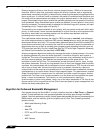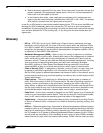
Firewall Settings > QoS Mapping
772
SonicOS 5.8.1 Administrator Guide
b. Row 2a shows an egress ACK for the class. Since class credit is less than the rate this
packet is queued in the appropriate ingress queue. And it will not be processed until
class credit is at least equal to the rate.
c. In the following time slices, class credit gets accumulated until it matches the rate.
Hence, after two time slices class credit becomes 1900 (620 + 640 + 640). The queued
ACK packet is process from the ingress pool at this point.
In row 2a, an ACK packet is received that needs to
be sent to the TCP source on the WAN zone.
Sending this ACK immediately would have caused the TCP source to send more packets
immediately. By queuing the ACK and sending it only after the class credit reaches the average
rate, we have reduced the TCP’s sending rate; i.e. by doing this we have slowed down the
ingress rate.
Glossary
• 802.1p – IEEE 802.1p is a Layer 2 (MAC layer) Class of Service mechanism that tags
packets by using 3 priority bits (for a total of 8 priority levels) within the additional 16-bits
of an 802.1q header. 802.1p processing requires compatible equipment for tag generation,
recognition and processing, and should only be employed on compatible networks. 802.1p
is supported on SonicWALL NSA platforms.
• Bandwidth Management (BWM) – Refers to any of a variety of algorithms or methods
used to shape traffic or police traffic. Shaping often refers to the management of outbound
traffic, while policing often refers to the management of inbound traffic (also known as
admission control). There are many different methods of bandwidth management, including
various queuing and discarding techniques, each with their own design strengths.
SonicWALL employs a Token Based Class Based Queuing method for inbound and
outbound BWM, as well as a discard mechanism for certain types of inbound traffic.
• Class of Service (CoS) – A designator or identifier, such as a layer 2 or layer 3 tag, that
is applied to traffic after classification. CoS information will be used by the Quality of
Service (QoS) system to differentiate between the classes of traffic on the network, and to
provide special handling (e.g. prioritized queuing, low latency, etc.) as defined by the QoS
system administrator.
• Classification – The act of identifying (or differentiating) certain types (or classes) of
traffic. Within the context of QoS, this is performed for the sake of providing customized
handling, typically prioritization or de-prioritization, based on the traffic’s sensitivity to
delay, latency, or packet loss. Classification within SonicOS Enhanced uses Access Rules,
and can occur based on any or all of the following elements: source zone, destination zone,
source address object, destination address object, service object, schedule object.
• Code Point – A value that is marked (or tagged) into the DSCP portion of an IP packet by
a host or by an intermediate network device. There are currently 64 Code Points available,
from 0 to 63, used to define the ascending prioritized class of the tagged traffic.
• Conditioning – A broad term used to describe a plurality of methods of providing Quality
of Service to network traffic, including but not limited to discarding, queuing, policing, and
shaping.
• DiffServ – Differentiated Services. A standard for differentiating between different types or
classes of traffic on an IP network for the purpose of providing tailored handling to the traffic
based on its requirements. DiffServ primarily depends upon Code Point values marked in
the ToS header of an IP packet to differentiate between different classes of traffic. DiffServ
service levels are executed on a Per Hop Basis at each router (or other DiffServ enabled
network device) through which the marked traffic passes. DiffServ Service levels currently


















